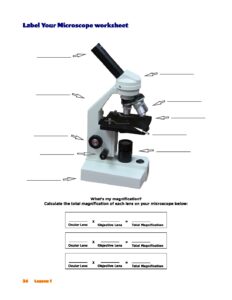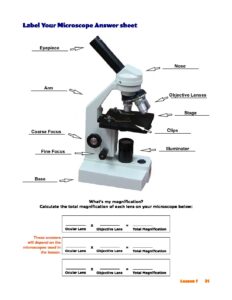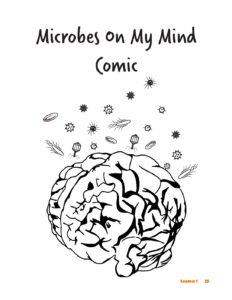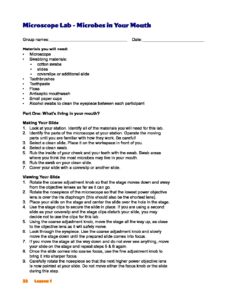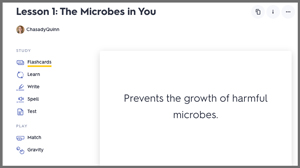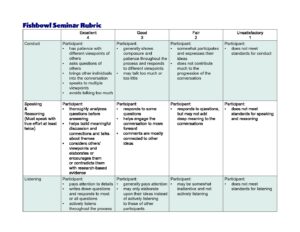Lesson 1: The Microbes in you: An Introduction to Microbiology
Youth read a comic book and use microscopes to explore the human microbiome.
Key Teaching Points
- Microbiology is the study of microorganisms or microbes.
- Microbes are single-cell living organisms that are too small to see without magnification.
- Some microbes are pathogens and harmful to our health.
- Other microbes are beneficial and important to our health.
Learner Outcomes
- Develop a basic understanding of microbiology.
Skill Level: 6-8th grade
Success Indicators
- Participants will identify the basics of microbiology.
- Participants will discuss observations from lab results and what the results mean with regard to daily life.
Life Skills
Teamwork, Healthy living, Critical thinking
Time Needed
2 days, approximately 90-120 minutes in total
Space
Classroom or area where there is ample space to set up desks/seats in two circles
Suggested Group Size
Groups of 4-5 for the lab activity
Materials
Materials
- Technology to present the presentation to the class
- Label Your Microscope worksheet (optional)
- Microbes on My Mind comic (one per participant)
- Microscope Lab – Microbes in Your Mouth instructions (one per group)
- Antiseptic mouthwash
- Microscope (one per group if possible)
- Swabbing materials (per group)
- cotton swabs
- 12-14 slides
- coverslips or additional slides
- Toothbrushes for each participant
- Toothpaste
- Floss for each participant
- Small paper cups (one per participant)
- Computer and internet access for groups
- Recording device for Public Service Announcement (if available, optional; these do not have to be recorded)
- Alcohol swabs to clean the microscope eyepiece
Introduction
Introduction
Did you know that there are tiny organisms that are all around you, on you, and inside you? These tiny organisms are called microbes. Microbiology is the study of microorganisms or microbes, which are very small organisms that cannot be seen with the human eye. In today’s society, much of the research in the field of microbiology focuses on biochemistry and pathology. Many microorganisms are what are known as pathogens or disease-carrying microorganisms, but not all microbes are pathogens! Some microorganisms are good guys and are necessary in our world. Did you know that the yogurt you eat contains good microbes because yogurt is a live culture? These good microbes help your gut digest food.
Before the Activity
- The day before this lab, tell participants to come to school without brushing their teeth if at all possible. Tell them that they will be investigating the microorganism jungles that live in their mouths.
- Preview the following videos to determine if you want to include them in the activities for this lesson:
What Causes Bad Breath? – Mel Rosenberg
What Causes Cavities? – Mel Rosenberg
- Prepare technology to show the presentation to the class.
- Assign participants to groups of 4-5.
- Prepare copies of the Microbes on My Mind comic for each participant.
- Prepare copies of the Label Your Microscope worksheet for each participant if this activity will be completed.
- Prepare copies of the Microscope Lab – Microbes in Your Mouth instructions (one per group).
- Make a decision about the format of the third part of the lesson. Options are given for a whole class discussion or a fishbowl seminar.
- If using the fishbowl seminar, set up desks or seating to accommodate this activity before the class begins if possible.
Fishbowl Seminar Instructions
- Create two circles, an inner circle, and an outer circle. The inner-circle should have 6-8 seats or fewer.
- The facilitator asks open-ended, higher-order thinking Generalize questions.
- Participants in the outer circle take notes on the participants speaking in the inner circle. They are not allowed to speak or answer any questions.
- Participants in the inner circle discuss openly about the higher-order thinking questions that the facilitator poses.
- Participants in the outer circle can tap the shoulder of a participant in the inner circle when they have a strong point to make. This is how the circles change and how everyone gets incorporated into the discussion.
- Circle sizes can be changed to meet the needs of the group, but make sure to have more people in the outer circle than the inner circle. It is recommended to have at least 3-4 participants in the inner circle.
- Facilitators may make it a requirement that everyone must speak X amount of times, if desired.
- For school teachers, there is a rubric that is based on ELA standards to help encourage speaking, writing, and thoughtful reasoning and discussion.
Part 1
Opening Questions
- What are microbes? Are they good or bad?
- Why might the study of small microorganisms be important?
Instructions
View the Microscope Video and have participants complete the Label Your Microscope worksheet.
Part 1 Assets
Part 2
Instructions
- Direct participants to move into their small groups.
- Open the lesson with a challenge to the participants:
- THEY ARE ALIVE AND THEY ARE ALL AROUND YOU! Look around the room and tell me if you can name one place where there are microorganisms lurking around us. Think of as many as you can in your groups in 2 minutes and then we will share with the class.
- Ask the Opening Questions.
- What are microbes? Are they good or bad?
- Why might the study of small microorganisms be important?
- Direct participants to read the Microbes on My Mind comic with
their small groups. - Share the presentation with the participants.
- Have small groups locate the Microscope Lab – Microbes in Your Mouth worksheet. Read the instructions for the lab with the participants as necessary.
- Caution: Make sure each participant uses their own swabbing brush for sanitation reasons. Make sure the microscope eyepiece is cleaned with an alcohol swab after each participant uses it.
- Participants will then discuss the differences they saw from their first slide to their second slide.
- Ask the Share Questions.
- What observations did you make about your first slide(s)?
- What observations did you make about your second slide(s)?
- What differences did you observe?
- They will try to answer WHY this occurred and talk about the importance of brushing their teeth. Try to get this discussion focused around microbes that naturally live in your mouth and the microbes we introduce through everyday activities such as eating food. Participants should begin realize that when they brush their teeth, they are making their mouth cleaner. Their data/results from their lab should reflect this.
Optional: If time permits, show one or more of the following short videos about bacteria.
This is a good stopping point if the class will be divided into two sessions.
Variations and Extensions
Swab your mouth before and after brushing and place it in a petri dish to allow the students to see the difference in bacteria that grows.
Have the children spit on pieces of bread before and after brushing and then place each piece of bread in a separate zip-bag so they can see the difference in bacteria growth over time on the bread.
Part 2 Assets
To address safety concerns related to COVID-19, you could substitute a video of this lesson instead.
Part 3
Instructions
- Engage the participants in a whole-class discussion or direct the fishbowl seminar.
- If using the fishbowl seminar, direct participants to seats in the fishbowl.
- Begin either activity by asking the Reflect question.
- After looking into the microorganism jungle in our mouths, what do you think is the purpose of antiseptic?
- Why should we use antiseptic?
- Continue the chosen discussion by asking the Generalize questions as appropriate.
- What other products around the house fight microorganisms?
- Why is the study of microbiology so important to our daily lives?
- How does understanding microbiology affect your daily life?
- Besides yogurt, what do you think are some other products that contain good microbes?
- Why is it important to have an understanding of good microbes and bad microbes? Give some examples.
- Why do you think it is important to have some good microbes in your mouth? What do you think their role is in your mouth?
- What do humans need to do to protect their body from bad microbes or pathogens? Give some specific examples.
- Direct the participants to rejoin their small groups from the microscope lab.
- Engage the participants in the Apply activity.
-
- In their groups of 4-5, participants will create an oral Public Service Announcement about the importance of understanding microbiology in our daily lives. They must specifically mention what are microbes and where they can be found, why individuals personally need to understand good microbes versus bad microbes, and some steps an individual can take to protect their body from bad microbes or pathogens. This should be about 1 minute in length. School teachers can get these Public Service Announcements to be played over the school news and Club leaders can contact local services to see if the participants can get their Public Service Announcement heard throughout the community. These can be recorded with a recording device if it is possible, or a script can be written, at the discretion of the facilitator.
Part 3 Assets
Dig Deeper
Optional
Let’s Play a Game to Test Your Knowledge!
Writing Prompt:
Pretend you are one of the microbes that currently live in your mouth. Tell a story about their day from the microbe’s perspective. Get creative with it! (ELA Connection: giving human characteristics to the microbes in your mouth is known as what?)


